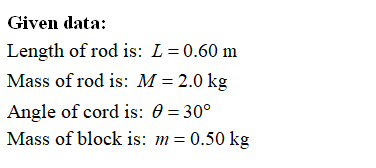The horizontal uniform rod shown below has length 0.60 m and mass 2.0 kg. The left end of the rod is attached to a vertical support by a frictionless hinge that allows the rod to swing up or down. The right end of the rod is supported by a cord that makes an angle of 30° with the rod. A spring scale of negligible mass measures the tension in the cord. A 0.50 kg block is also attached to the right end of the rod. (Source: College Board, AP Physics C Exam) Hinge 2.0 kg- Spring scale 30⁰7 0.60 m (b) Calculate the reading on the spring scale. 4 0.50 kg (a) On the diagram below, draw and label vectors to represent all the forces acting on the rod. Show each force vector originating at its point of application. (c) Calculate the magnitude of the force exerted by the hinge on the rod
The horizontal uniform rod shown below has length 0.60 m and mass 2.0 kg. The left end of the rod is attached to a vertical support by a frictionless hinge that allows the rod to swing up or down. The right end of the rod is supported by a cord that makes an angle of 30° with the rod. A spring scale of negligible mass measures the tension in the cord. A 0.50 kg block is also attached to the right end of the rod. (Source: College Board, AP Physics C Exam) Hinge 2.0 kg- Spring scale 30⁰7 0.60 m (b) Calculate the reading on the spring scale. 4 0.50 kg (a) On the diagram below, draw and label vectors to represent all the forces acting on the rod. Show each force vector originating at its point of application. (c) Calculate the magnitude of the force exerted by the hinge on the rod
College Physics
10th Edition
ISBN:9781285737027
Author:Raymond A. Serway, Chris Vuille
Publisher:Raymond A. Serway, Chris Vuille
Chapter8: Rotational Equilibrium And Rotational Dynamics
Section: Chapter Questions
Problem 28P
Related questions
Concept explainers
Rotational Equilibrium And Rotational Dynamics
In physics, the state of balance between the forces and the dynamics of motion is called the equilibrium state. The balance between various forces acting on a system in a rotational motion is called rotational equilibrium or rotational dynamics.
Equilibrium of Forces
The tension created on one body during push or pull is known as force.
Question

Transcribed Image Text:15. The horizontal uniform rod shown below has length 0.60 m and mass 2.0 kg. The left end of the
rod is attached to a vertical support by a frictionless hinge that allows the rod to swing up or
down. The right end of the rod is supported by a cord that makes an angle of 30° with the rod. A
spring scale of negligible mass measures the tension in the cord. A 0.50 kg block is also
attached to the right end of the rod. (Source: College Board, AP Physics C Exam)
Hinge
2.0 kg-
Spring scale
30º
0.60 m
(b) Calculate the reading on the spring scale.
+
0.50 kg
(a) On the diagram below, draw and label vectors to represent all the forces acting on the rod.
Show each force vector originating at its point of application.
(c) Calculate the magnitude of the force exerted by the hinge on the rod
Expert Solution
Step 1

Trending now
This is a popular solution!
Step by step
Solved in 4 steps with 4 images

Knowledge Booster
Learn more about
Need a deep-dive on the concept behind this application? Look no further. Learn more about this topic, physics and related others by exploring similar questions and additional content below.Recommended textbooks for you

College Physics
Physics
ISBN:
9781285737027
Author:
Raymond A. Serway, Chris Vuille
Publisher:
Cengage Learning

Glencoe Physics: Principles and Problems, Student…
Physics
ISBN:
9780078807213
Author:
Paul W. Zitzewitz
Publisher:
Glencoe/McGraw-Hill

Principles of Physics: A Calculus-Based Text
Physics
ISBN:
9781133104261
Author:
Raymond A. Serway, John W. Jewett
Publisher:
Cengage Learning

College Physics
Physics
ISBN:
9781285737027
Author:
Raymond A. Serway, Chris Vuille
Publisher:
Cengage Learning

Glencoe Physics: Principles and Problems, Student…
Physics
ISBN:
9780078807213
Author:
Paul W. Zitzewitz
Publisher:
Glencoe/McGraw-Hill

Principles of Physics: A Calculus-Based Text
Physics
ISBN:
9781133104261
Author:
Raymond A. Serway, John W. Jewett
Publisher:
Cengage Learning

Physics for Scientists and Engineers: Foundations…
Physics
ISBN:
9781133939146
Author:
Katz, Debora M.
Publisher:
Cengage Learning

College Physics
Physics
ISBN:
9781938168000
Author:
Paul Peter Urone, Roger Hinrichs
Publisher:
OpenStax College

Physics for Scientists and Engineers, Technology …
Physics
ISBN:
9781305116399
Author:
Raymond A. Serway, John W. Jewett
Publisher:
Cengage Learning